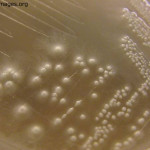 The discovery of antibiotics was no doubt a turning point in medicine, saving countless lives. However they have unfortunately become one of the most overused classes of medication. Studies show that 30-50% of antibiotics prescribed in hospitals are either unnecessary or incorrect.
The discovery of antibiotics was no doubt a turning point in medicine, saving countless lives. However they have unfortunately become one of the most overused classes of medication. Studies show that 30-50% of antibiotics prescribed in hospitals are either unnecessary or incorrect.Like any other drug taken into the body, antibiotics have their list of possible negative effects. Here I will focus on yeast infections as a negative effect or complication of taking antibiotics.
But first some general information. On and in our bodies are billions of germs including bacteria, viruses, and yeast. The germs all exist together in a balance, getting whatever nutrients they need from our bodies.
Antibiotics are prescribed specifically to kill infections caused by bacteria type germs. However, in addition to killing the bad bacteria causing the infection, the antibiotic also kills many of the good bacteria. As a result, the balance is thrown off and there is disproportionately more yeast present. The way I like to put it, is that the yeast has less competition from bacteria for the available “food” and so they overgrow, becoming more plentiful. The overgrowth may progress to the point where the affected person starts experiencing symptoms because there is now a yeast infection.
5 examples of yeast infections resulting from antibiotics are:
1. Thrush – this is an overgrowth of the normal yeast present in the mouth (Candida type). It may be mild with soreness or irritation of the surfaces of the mouth. This can progress to the point where the yeast is visible as thick, curd-like white plaques in the mouth. When thrush gets really severe, it can extend into the throat and down the feeding tube (esophagus) causing severe pain with swallowing.
2. Angular cheilitis – this is a yeast infection of the corners of the mouth. They get so sore and raw that when the person opens the mouth wide to laugh for example, there is cracking and bleeding.
3. Intertrigo – this is irritation/itching and rawness affecting the folds of the skin such as the armpits, under the breasts in women, in the groin and buttock creases. It is commonly referred to as chaffing. Yeast tend to like warm, moist areas so they thrive in theses regions and wreak havoc when there is less skin bacteria around.
4. Vaginal yeast infection – the most talked about type of yeast infection. Similar to thrush, there is a curd-like discharge from the vagina and significant itching/irritation.
5. Balanitis – this is an infection of the glans penis (head of the penis) and sometimes the foreskin in uncircumcised men. There is redness, swelling, oozing from cracks, and the same curd-like plaques over the affected areas.
So there you have it, 5 examples of yeast infections complicating antibiotic treatment. As you can see, both men and women may be affected. The longer the antibiotic treatment duration, the higher the chance of at least one type of yeast infection. (Quick point: antibiotics are not the only cause of the infections outlined above. Uncontrolled diabetes is a huge cause, but more on diabetes and infection in future posts.)
For prevention, avoidance of unnecessary antibiotics is the key. However this is not always feasible. But, have no fear – there is treatment. Mild cases can be treated with anti fungal solutions and creams, but more severe cases will require anti fungal medication in tablet, and rarely, intravenous (drip) form.
 Anonymous says
Anonymous says
August 25, 2016 at 11:59 amA really good friend of mine struggled for months with a recurrent UTI that she could just not get rid of. She would be put on antibiotics, it would seem to get better, and then it would come back. This happened several times and I think she was put on about 3 different antibiotics during this time. She had all the classic symptoms of a UTI. Her doctor finally referred her to a urologist who determined she had a yeast infection the whole time. I believe a UTI did start everything but after that it was yeast and of course the constant antibiotic use was making it worse. She was treated for the yeast infection and everything has been fine since! Thought that was an interesting experience. I’ve always known yeast overgrowth could occur with antibiotic use but never thought about it being an issue after a UTI.
 infectiousmd says
infectiousmd says
August 26, 2016 at 8:01 pmYes, yeast infections in women do not have to be the classic “cheesy” vaginal discharge. Sometimes it is external irritation which also involves the opening where the urine drains out (urethral meatus) in addition to the surrounding external vagina. Because of the irritation, when the urine touches the area, it burns significantly. Compare that to the classic burning with a UTI which tends to be more ‘internal.’
Thank you for reading and also for your comment!